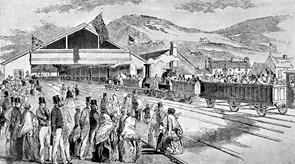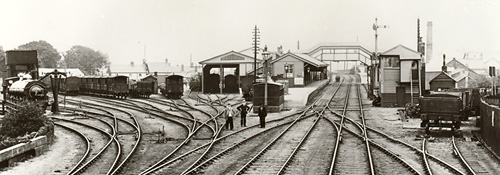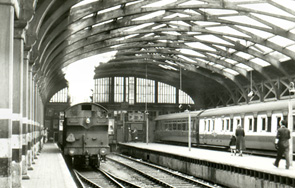Timber Railway Viaducts in Wales
Other timber structures
A brief mention of other structures associated with the railways engineered by
Isambard Kingdom Brunel (1806-1859) in Wales.
Other structures : Taff Vale Railway
Construction of the Taff Vale Railway included timber bridges, and by all accounts, railway stations — though little remains. In 1837, tenders were sought for timber bridges at Taffs Well and at Pentyrch, both of which are near Cardiff. Evidence of a timber railway building can be found in a reference by W. Davies in his report of the station in Queen Street (then known as Crockherbtown), Cardiff, shortly after the line opened. He writes, "The Taff Vale Railway station in Queen Street in 1842, when I first passed through Cardiff to Trefforest, was a wooded structure".
Other structures : South Wales Railway
The notable timber building on the South Wales Railway was Swansea Station (opened 1850). It has undergone many changes over the years since. In 1877-78, offices were constructed in Pennant stone to the west of the station. In 1924-26, the structural fabric of the station was altered. The original all-over roof format changed to include pitched steel-frame awnings (standard 1930s Great Western Railway pattern) over the platforms. A fifth platform was also added. In 1934, the station was remodelled to allow for longer trains and the main terminal block facing Swansea High Street constructed.
Other structures : Vale of Neath Railway
Timber was used extensively for station buildings on this line. At Aberdare, a timber all-over roof station complete with goods shed survived until 1982, when it was destroyed by fire. Aberdare was originally a terminus station of the Vale of Neath Railway. It became a through station less than three years after the opening, when the line was extended to the canal head half a mile away in June 1853.
Brunel's High Street station at Merthyr Tydfil was completed in 1853. From 1878, it operated as a joint station. The design was unusual for Brunel in its use of curved roof beams. The roof was removed in 1953 and the rest of the station replaced in 1974. Marthyr Tydfil Station has since been moved to a new location, and the old station site occupied partly by a supermarket.

Brunel's timber Swansea Station in June 1850, at the opening of the South Wales Railway.
Image: Stephen K. Jones collection
Aberdare Station, also by Brunel, in about 1899. The timber all-over roof station can be seen in the middle.
Image: Stephen K. Jones collection
Merthyr Tydfil Station (1853, Vale of Neath Railway, Brunel). The photo was taken on 4th August 1952.
Photo: courtesy Ian L. Wright







